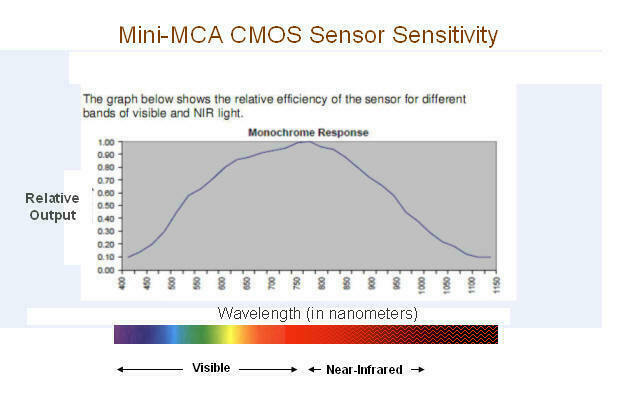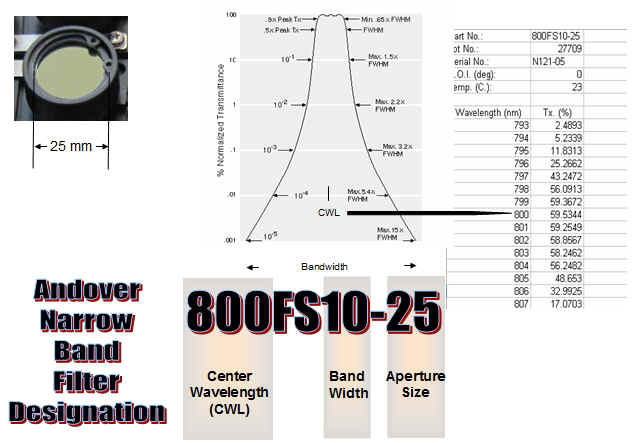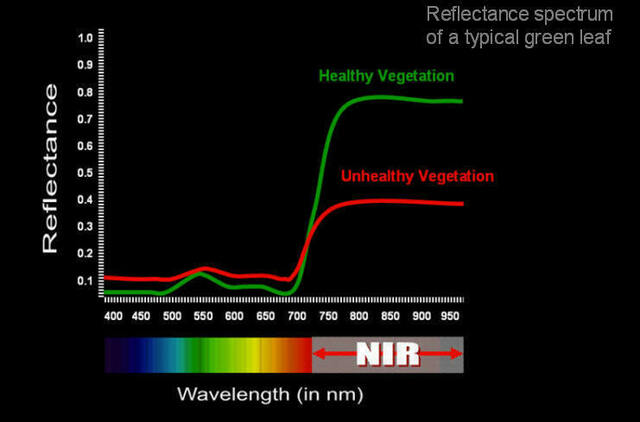|
TECHNICAL
PARAMETERS AFFECTING MINI-MCA BAND-PASS FILTER SELECTION
Electric
current is developed in an image sensor in response to the
electromagnetic radiation that contacts it. The amount of
current
generated depends upon the brightness and wavelength of the radiation
hitting the sensor. For a given brightness, Mini-MCA output
is
greatest in response to wavelengths in the area of 800nm. The output
drops in a smooth curve to an approximate 20% peak output at 450 nm in
the visible spectrum and 1050 nm in the near-infrared at
the limits of its range. A
graph of the sensitivity of the camera's image sensor to impinging
radiation is shown below.

The
spectroscopic filters used in Mini-MCA systems are supplied by Andover
Corporation. These
are placed between each Mini-MCA camera's lens and sensor.
The
filters restrict the radiation that is able to contact the sensor to a
narrow band of wavelengths. Andover filter
designations
indicate the filter's center wavelength, band width and the size of the
aperture they fit. All Mini-MCA systems use filters with a 25
mm
diameter.

The amount of light that is allowed to hit the
sensor increases as
filter bandwidth increases. As a rule, 10 nm bandwidths
provide
optimum multi-spectral imagery in Mini-MCA systems. Wider
bandwidths tend to over saturate the sensor. The exceptions
to
this occur at the limits of the sensor's sensitivity range.
Here,
the greater amount of light that broader bandwidth filters pass is
offset by the sensor's decreased sensitivity.
ORDERING AND REPLACING
MINI-MCA BAND-PASS FILTERS
MCA filters are customer-designated at the time of
order. The
filters are field-replaceable using standard 25mm spectrometer filters
so Mini-MCA systems may be reconfigured in the field to sense entirely
new spectral combinations. Field replacement of filters is
limited by the following considerations:
Since
wavelength impacts focus, Mini-MCAs are initially set up in the factory
for optimum focus based on the wavelengths of the filters initially
selected by the user. Changing filters in the field, changes
the
camera's focal point. To insure the Mini-MCAs cameras provide
optimum focus, users should only replace a Mini-MCA filter that is near
the wavelength of the filter originally inserted into that
camera.
In
the visible spectrum, replacing a filter with a new one that is within
plus or minus 100 nm of the original is acceptable. Beyond
700
nm, replacement filters should be within plus or minus 50 nm of the
original. Replacement of filters beyond this range requires
factory re-focusing of the unit.
SELECTING
OPTIMUM MINI-MCA
BAND-PASS FILTERS
FOR YOUR APPLICATION
Both
Andover's standard and custom filters may be used for Mini-MCA
applications. The filters we select to include in our
standard
filter sets are chosen based on their ability to expose conditions able
to be derived from vegetation spectral reflectance curves such as the
one shown below.

The selection
criteria we use are based on the following factors:
We select filters for our standard filter set from
Andover's list of Standard Filters. This is available on the Andover
Corporation website.
Customers may pick any filter from Andover's Standard
List to substitute for a filter in our Standard Filter Set with no
change in the product's price. The price of custom filters
are
quoted at the time of their order.
Below is a list of filters in the Standard Filter
Set for each Mini-MCA model with a description of each filter's uses
MINI-MCA STANDARD
FILTERS AND
THEIR USES
|
Mini-MCA
Model
Number
|
Filter
Designation
|
Reason
for Inclusion in Standard Set (Filter Uses or Significance)
|
| Mini-MCA4 |
|
|
| - 490FS10-25 |
Blue
- Ten nanometer slice of Landsat 5 TM Band 1, This provides
increased penetration of water bodies and also is capable of
differentiating soil and rock surfaces from vegetation and for
detecting cultural features.1 This is
the point of
crop to soil reflectance ratio minima for blue and green bands. The
band is sensitive to loss of chlorophyll, browning, ripening,
senescing, and soil background effects). It is also sensitive to
senescing rates and is generally an excellent predictor of grain yield.2
|
| - 550FS10-25 |
Green - Ten nanometer
slice of Landsat 5 TM Band 2, it is sensitive to water turbidity
differences.1 Positive change in
reflectance per unit change in wavelength of this visible spectrum is
maximum around this band. 2 The so
called "green hump" in vegetation spectral reflectance curves is useful
in predicting chlorophyll content. 3 |
| - 680FS10-25 |
Red
- Ten nanometer slice of Landsat 5 TM Band 3, this may be
used in
the derivation of the Normalized Difference Vegetation Index where NDVI=(TM4-TM3)/(TM4+TM3).
Cited for NDVI measurement by ENVI with 800 nm 9
Absorption in the red band (600 to 700 nm) varies significantly due to
changes in factors such as biomass, LAI soil background, cultivar
types, canopy structure, nitrogen, moisture, and stress in plants 2
Note: Users may
substitute a 660 nm filter with designation of 660FS10-25 for the 680
nm designated 680FS10-25. The 660 nm filter is a common
choice among Tetracam customers. This is the chlorophyll
absorption pre-maxima (or reflectance minima). Absorption in the red
band (600 to 700 nm) varies significantly due to changes in factors
such as biomass, LAI soil background, cultivar types, canopy structure,
nitrogen, moisture, and stress in plants 2 |
| - 800FS10-25 |
NIR - Ten nanometer
slice of Landsat 5 TM Band 4, this may be used in derivation of
Normalized Difference Vegetation Index where NDVI=(TM4-TM3)/(TM4+TM3).
Cited for NDVI measurement by ENVI with 680 nm 9
This may also be used in derivation of an NDVI variant called
Re-normalized Difference Vegetation Index where RDVI=(R800 -
R671))/(R800 + R671)1/2
. RDVI is based on the contrast between the maximum
absorption in the red due to chlorophyll pigments and the maximum
reflection in the infrared caused by leaf cellular structure.
This filter also plays a role in a Modified Soil Adjusted Vegetation
Index (MSAVI) developed to cancel soil reflectance and Soil and
Atmospherically Resistant Vegetation Index (SARVI), which minimizes
both canopy background and atmospheric effects, 7
This filter is also useful in calculations of various plant pigment
ratios such as Pigment Specific Simple ratio Chl (PSSR), Pigment
Specific Normalized Difference (PSND) and Structure-Insensitive Pigment
Index (SIPI). Ratios between plant pigments often change in
response to specific vegetation stress conditions such as changes in
the carotenoid/chlorophyll ratio in apple trees in response to mite
attacks. 6 |
| |
|
| Mini-MCA6 |
|
|
| - 490FS10-25 |
- See Mini-MCA4 |
| - 550FS10-25 |
- See Mini-MCA4 |
| - 680FS10-25 |
- See Mini-MCA4 |
| - 720FS10-25 |
-
Red Edge - The red edge describes the steeply sloped region of the
vegetation spectral reflectance curve between 690 nm and 740 nm that is
caused by the transition from chlorophyll absorption of red wavelengths
and near-infrared reflection due to the mesophyll cells in leaves which
in healthy plants act like a mirror to NIR. This band is
sensitive to temporal variations in crop growth and vegetation stress
and provides additional information about chlorophyll and nitrogen
status of plants. 2. |
| - 800FS20-25 |
- See Mini-MCA4 |
| - 900FS20-25 |
-NIR-
Peak or maximum reflectance region of the NIR spectrum for certain
types and/or growth stages of vegetation or crops. For crops
such
as cotton and corn or when crops are under stress or senescing there is
significant change in reflectance along the "NIR shoulder."
Useful for computing crop moisture sensitive index. 2. |
| |
|
|
Mini-MCA12
|
|
|
|
- 490FS10-25
|
-
See Mini-MCA4 |
| - 520FS10-25 |
-Green
- Positive change in reflectance per unit change in wavelength of this
visible spectrum is maximum around this "green" waveband. First order
derivative plot of crop spectra will show this. Green band
peak
(or the point maximal reflectance) in the visible spectrum. 2 |
| - 550FS10-25 |
-
See Mini-MCA4 |
| - 570FS10-25 |
- Green -Negative change
in reflectance per unit change in wavelength of the visible spectrum is
maximum around this wavelength.2
Factor in photochemical reflectance index (PRI) for estimating
photosynthetic light use efficiency. Also compares the reflectance in
the red and blue regions of the spectrum.3
Used
as factor in calculating PRI for xanthophyll cycle pigment change
detection, carotenoid/chlorophyll ratio monitoring and water stress
detection.4 |
| - 671FS10-25 |
-Red
- This may be used in the derivation of an NDVI variant called
Re-normalized Difference Vegetation Index where RDVI=(R800 -
R671) / (R800 + R671)1/2
. RDVI is based on the contrast between the maximum
absorption in
the red due to chlorophyll pigments and the maximum reflection in the
infrared caused by leaf cellular structure. This filter also plays a
role in a Modified Soil Adjusted Vegetation Index (MSAVI) developed to
cancel soil reflectance in NDVI calculations and Soil and
Atmospherically Resistant Vegetation Index (SARVI), which minimizes
both canopy background and atmospheric effects, 7
|
| - 680FS10-25 |
-
See Mini-MCA4 |
| - 700FS10-25 |
-
Red Edge - This is a second red edge monitoring wavelength.
The
red edge slope decreases as NIR reflectance drops in insect-damaged
foliage. The wavelength and point of maximum slope also shift during
senescence or stress-induced chlorosis. 8
So,Red Edge Position (REP) is an excellent indicator of plant stress
and growth. 2. Also a factor in
Chlorophyll Absorption in Reflectance Index (CARI) used in estimating
chlorophyll content in crops. 6 |
| - 720FS10-25 |
-
See Mini-MCA6 |
| - 800FS10-25 |
- See Mini-MCA4 |
|
- 840FS10-25
|
NIR
- This filter's maximum transmissivity actually occurs at 845
nm. This operates in the best spectral region to distinguish
vegetation varieties and conditions. This is the
center of the "NIR shoulder." For many crops, a broad-band or
a narrow-band will provide the same result due to near uniform
reflectance throughout the NIR shoulder (740 to 940 nm). In such
instances, other bands along the NIR shoulder will be redundant. |
| - 900FS20-25 |
-
See Mini-MCA6 |
|
- 950FS40-25
|
-NIR
- Center of the moisture sensitive "trough" portion of NIR. The
"trough" portion varies from 940 to 1040 nm and typically has minimum
reflectance around 975 nm (or point of maximum "dip" in the trough
portion). Plant moisture sensitive band.2 This
band is used in calculation of the Water Band Index where WBI = P900 /
P970 9 |
| |
|
1 Band Combinations (James Quinn) University of Northern Iowa
2 Evaluation
of Narrowband and Broadband Vegetation Indices for Determining Optimal
Hyperspectral Wavebands for Ag Crop Characterization
3 Relationships
between leaf pigment content and spectral reflectance across a wide
range of species, leaf structures and developmental stages
4 Assessing canopy PRI for water stress
detection with diurnal airborne imagery
5 Vegetation
indices as indicators of damage by the sunn pest (Hemiptera:
Scutelleridae) to field grown wheat
6 Soil
Backgrounds Impact Analysis on Chlorophyll Indices Using Field,
Airborne and Satellite Hyperspectral Data
7 Hyperspectral
vegetation indices and novel algorithms for predicting green LAI of
crop canopies
8 Spectral reflectance characteristics of
eucalypt foliage damaged by insects
9 Reference ENVI Users Guide
|
